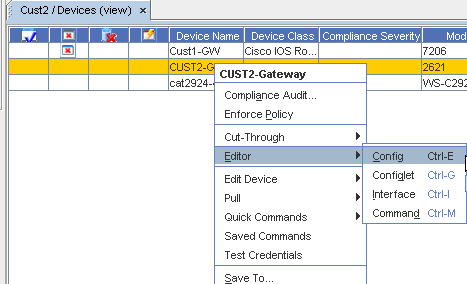The intent of the Command is not to change or update a device's configuration, although a Command can be used for this purpose. The intent is to provide access to device-level information for completing actions, such as:
-
Providing a verification if a previous configuration change was completed correctly. For example, sending a "show interfaces" command to see that a new interface was successfully added.
-
Completing tasks on the router for verifying the integrity of the network. This includes completing pings, tracers, and show routes.
-
Completing router verification and diagnostics. This includes running internal diagnostics on a router, rebooting a router, and reloading alternate configurations.
Once a command has been pushed and scheduled on the device server, it is sent via a new DASL Device Driver. These script extensions work exactly like the regular PUSH sections, except they do not enter "conf t" mode prior to sending the commands to the device.
The Command Editor is accessible:
-
When the Command
 icon is active. For example, in a workspace.
icon is active. For example, in a workspace. -
By right-clicking on a device and selecting Editor -> Command from the menu. The right-click menu feature is used in the navigation pane and accessible on any device to provide shortcut access to other features. For example: Editors, Wizards, Cut-Through functions, and more.
A Command can be created for one or more devices. The Command is then scheduled for all devices that are affected by the Command.
A Command is used to send a scriptlet, written in the router's command-line language (for example, IOS for Cisco devices) to a device that is then executed on the device, and the results returned to the user.
To open one or more Command files,
-
If you are using the Table layout to view devices, select devices from the table. Or, if you are using the Diagram view, select the devices.
Note: In a Table layout, a series of devices can be selected by holding down the Shift key while selecting devices. Or, in a Table or Diagram layout, select multiple devices can be selected by holding the Ctrl key while selecting devices. -
Select Editors, then Command.

When a single device is selected, one editor window opens. If more than one device is selected, the single editor session contains the selected devices listed in the Devices Column.